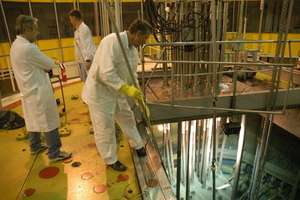1 week of MARIA reactor operation=radiopharmaceuticals for 100,000 patients

Polish MARIA research reactor is saving the day in world nuclear medicine in time when the Dutch research reactor in Petten had to be unexpectedly shut down. NCBJ has scheduled some additional irradiation sessions to deliver additional portions of Molybdenum-99 in amount sufficient to perform extra 300,000 medical procedures, and that way to fill an unexpected gap on the nuclear medicine preparation market.
Just 8 research reactors in the world (5 in Europe) are adopted to irradiate uranium targets used to produce Molybdenum-99 radioisotope. This short lifetime isotope is necessary to produce radiopharmaceuticals for nuclear medicine. Output of those reactors is sufficient to perform annually over 25 millions medical procedures in cancer diagnostics. If only one of the reactors fails to produce irradiated uranium targets, continuity of supply of Molybdenum-99 preparations is immediately in danger.
The Dutch research reactor in Petten is one of the reactors adopted to irradiate uranium targets. In second half of November they experienced unexpected technical problems. Dutch nuclear regulatory authority ordered to shut the facility down and commenced detailed analyses of the situation. It is yet not known how long the break in reactor operation is going to last.
"This is a normal procedure in the nuclear industry. As soon as any disturbing signal has appeared, reactor is immediately shut down and experts nominated by national nuclear regulatory authority are analysing the situation. Unfortunately, any such incident in a research reactor involved in production of radioisotopes for nuclear medicine is a bad news for oncology hospitals," explains Professor Grzegorz Wrochna, NCBJ Director General. "Every delay in treatment of cancer might mean life or death for their patients. We couldn't make any other decision than to help them."
Since Polish MARIA research reactor operated in Świerk is adopted to irradiate uranium targets necessary to produce Molybdenum-99, Covident – a global pharmaceutical manufacturer – asked NCBJ for assistance. NCBJ management immediately made a decisions to run some additional sessions to irradiate extra uranium targets sufficient to produce Molybdenum-99 in amount needed for about 300,000 medical procedures to be performed all over the world. That way continuity of supply of the radiopharmaceutical will be assured for 3 weeks at the 2012/2013 turn.
Molybdenum-99 is produced as a result of some nuclear reactions running once uranium targets have been irradiated inside core of a research reactor. The targets are loaded into some specially adopted channels inside the core in place of normally loaded fuel rods. Irradiated uranium targets (exhibiting the required activity of Molybdenum-99 radioisotope) are moved to hot chambers, in which they are packed into special shipping containers. The containers are shipped to a manufacturing laboratory in the Netherlands, where the Technetium-99m radioisotope is extracted out of the targets. That latter isotope is used as a radioactive label of some biologically active substances used in preparations applied in some nuclear medicine procedures. The administered preparations are selectively absorbed by cancer tissue. Detectors of ionizing radiation emitted by radioactive label may then image lesions in patient body without a need to perform complicated surgery.
This is not the first case when Polish MARIA research reactor is used to assist in emergency global manufacturers of nuclear medicine preparations.
"Such incidents happened already in the past: in 2007 in Canada and at the turn of 2009/2010 in the Netherlands. Those shutdowns gave rise to large crises on the Molybdenum-99 market, with negative consequences to the entire nuclear medicine branch all over the world. In March 2010 we decided to start irradiation of uranium targets and to produce molybdenum also in our reactor. That way we helped millions of patients all over the world," explains Eng. Grzegorz Krzystoszek, Head of the NCBJ Nuclear Energy Department. "To-day we can see once more how that decision was right."
Provided by National Center for Nuclear Research















